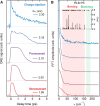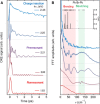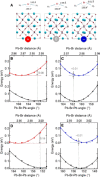Large polarons in lead halide perovskites
- PMID: 28819647
- PMCID: PMC5553817
- DOI: 10.1126/sciadv.1701217
Large polarons in lead halide perovskites
Abstract
Lead halide perovskites show marked defect tolerance responsible for their excellent optoelectronic properties. These properties might be explained by the formation of large polarons, but how they are formed and whether organic cations are essential remain open questions. We provide a direct time domain view of large polaron formation in single-crystal lead bromide perovskites CH3NH3PbBr3 and CsPbBr3. We found that large polaron forms predominantly from the deformation of the PbBr3- frameworks, irrespective of the cation type. The difference lies in the polaron formation time, which, in CH3NH3PbBr3 (0.3 ps), is less than half of that in CsPbBr3 (0.7 ps). First-principles calculations confirm large polaron formation, identify the Pb-Br-Pb deformation modes as responsible, and explain quantitatively the rate difference between CH3NH3PbBr3 and CsPbBr3. The findings reveal the general advantage of the soft [PbX3]- sublattice in charge carrier protection and suggest that there is likely no mechanistic limitations in using all-inorganic or mixed-cation lead halide perovskites to overcome instability problems and to tune the balance between charge carrier protection and mobility.
Figures





References
-
- Miyano K., Tripathi N., Yanagida M., Shirai Y., Lead halide perovskite photovoltaic as a model p−i−n diode. Acc. Chem. Res. 49, 303–310 (2016). - PubMed
-
- Yin W.-J., Shi T., Yan Y., Unusual defect physics in CH3NH3PbI3 perovskite solar cell absorber. Appl. Phys. Lett. 104, 063903 (2014).
-
- Xing G., Mathews N., Sun S., Lim S. S., Lam Y. M., Grätzel M., Mhaisalkar S., Sum T. C., Long-range balanced electron- and hole-transport lengths in organic–inorganic CH3NH3PbI3. Science 342, 344–347 (2013). - PubMed
-
- Dong Q., Fang Y., Shao Y., Mulligan P., Qiu J., Cao L., Huang J., Electron-hole diffusion lengths > 175 um in solution-grown CH3NH3PbI3 single crystals. Science 347, 967–970 (2015). - PubMed
Publication types
LinkOut - more resources
Full Text Sources
Other Literature Sources

